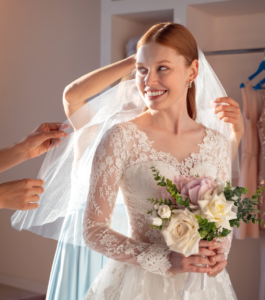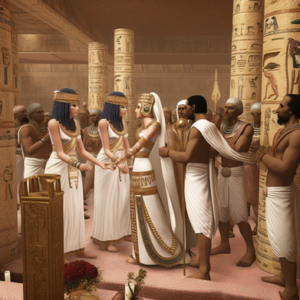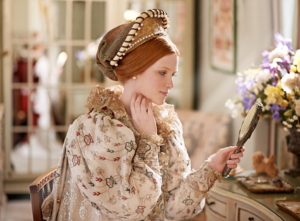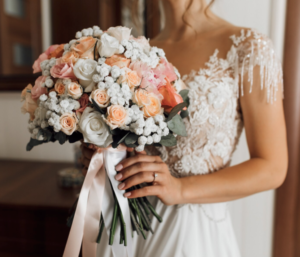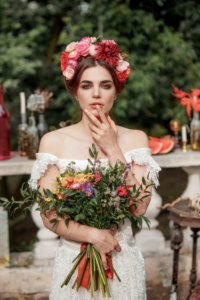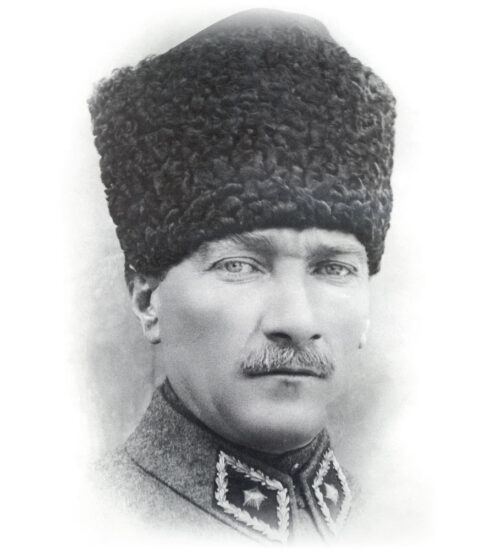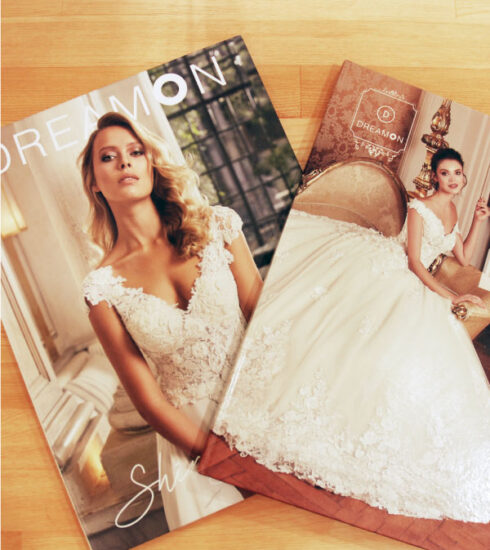Gelin ve Çiçek
Duvağından gelin tacına, ayakkabısından eldivenlerine kadar gelinliği tamamlayan pek çok aksesuar var. Çiçekler, bu aksesuarlar arasında en anlamlı olanı.
Yepyeni, sevgi ve umut dolu bir yolculuğa çıkan gelin ile sevgi, tazelik, güzellik, naiflik gibi anlamlar yüklenen çiçek arasındaki ilişki çok derin. Hemen hemen her kültürde düğün esnasında bir şekilde gelin ve çiçeğin bir araya geldiğini görüyoruz.
Şimdi gelin, başlangıcı yüzyıllar öncesine kadar uzanan “gelin ve çiçek” birlikteliğini inceleyelim.
Gelin ve çiçekler arasındaki anlamlı ilişki…
Çiçeklerin bizim kültürümüzde önemli bir yeri var. Hikayelerde, manilerde sembolik olarak da kullanılmış olan çiçekler, sevgi, bereket, güzellik gibi kavramlarla bağdaştırılmış ve gerek sanatta gerekse de düğünlerde yaygın olarak kullanılmış. Kültürümüzde gelinlerin düğünlerde başlarına taktıkları yazma ve başlıklarda rengarenk iğne oyası çiçek motiflerinden ya da çiçek şekilli mücevherlerden bol bol yararlanılmış. Çiçekler, gelinin giyeceği ipekli ya da kadife kumaşlara işlenmiş.
Eski Türklerin bazı boylarında damadın arkadaşları düğün alayı ile kız evine gider ve sağdıç gelin için bir demet çiçek hazırlarmış. Gelin, atla alınıp oğlan evine getirilince, damat ve sağdıç atın yanına yaklaşıp gelini indirir, hemen ardından da sağdıç, önceden özenle hazırlanmış çiçeği geline verirmiş. Buna benzer adetlerimiz hale devam ediyor.
Çiçekler, Osmanlılarda saray düğünlerinde yaygınlıkla kullanılırmış. Düğünün yapılacağı yerler çiçeklerle süslenirmiş. Damadın saraya göndermek zorunda olduğu mücevher ya da giysiler yanında çiçeklerin de yer alması olmazsa olmaz bir adetmiş. 3. Ahmet’in kardeşi olan Safiye Sultan ile evlenen Ali Paşa’nın gönderdiği değerli hediyeler arasında çiçeklerin olduğu Osmanlı arşiv belgelerinde de yer almakta. Bunun yanı sıra, halkın merakla izlediği çeyiz alaylarının geçişi sırasında tablalar halinde çiçekler bulundurulması da zamanın adetleri arasındaymış.
Roma ve Mısır gelinleri…
Roma ve Mısır medeniyetlerinde gelin adayları, kötülüklerin yaklaşmaması amacıyla ellerinde kokulu otlar taşırlarmış. Bu kokulu otlardan biberiye sadakati, aradaki bağın gücünü ise sarmaşık temsil edermiş.
Gelinin korunması için ise fesleğen ya da çörek otu bulundurulurmuş. Taktıkları çiçekli taçlar doğurganlığın ve yeni başlangıçların simgesiymiş. Bunun yanı sıra, çiçekler o zamanlarda da düğünlerde dekorasyon amacıyla da kullanılırmış.
Gelelim Avrupa Ortaçağ’ına…
Türkler olarak binlerce yıldır suya saygı ve temizliğe özen gösteren bir ırk olduk. Ortaçağ Avrupa’sında ise durum bambaşka; her ne kadar Roma döneminden kalan banyolar kullanılıyor olsa da, bunlar artan nüfustan dolayı yetersiz kalıyormuş. Salgın hastalıklar, şehir sokaklarındaki hayvan pislikleri, atıkların sokağa dökülmesi nedeniyle hijyen yokmuş. Bir de bu yetmezmiş gibi dini önderlerden olan Aziz Julian müritlerine yıkanmayı yasaklamışken, Aziz Jerome “banyo sadece vaftiz sırasında olur” diyerek tebasını yönlendiriyormuş. Hristiyanlar, haliyle yıkanmayı neredeyse rafa kaldırmışlar. Yıkanmak çoğu zaman yalnızca testideki suyun vücuda dökülmesinden ibaretmiş. Halk yıkanmak için evlerine su taşımak zorunda kalıyor, üstelik hepsi aynı fıçının içinde büyükten küçüğe gittikçe kirlenen su içinde sırayla yıkanıyorlarmış. Varın, o zamanlarda yıkanmamanın getirdiği o kötü kokuyu siz düşünün…
Bazı kaynaklara göre ise Avrupa Orta çağında yılın ilk banyosu Mayıs’ta yapılırmış.
Devrin pis kokusunu engellemenin tek yolu ise kokulu çiçek ya da otlardan geçiyormuş. Bazı araştırmacılar, düğünlerde kullanılan çiçek buketinin kullanımını bu sebebe bağlıyorlar. Onlara göre, düğün esnasında vücutlarından çıkan kötü kokuları gizlemek için gelinlerin çiçek buketi taşımaları gerekiyormuş.
Bir başka iddiaya göre ise gelin, düğünün yapılacağı kiliseye gidene kadar köyün içinden yürür, bu sırada köylüler çevreden kopardıkları çiçekleri ona verirlermiş. Gelin ise elinde buket haline gelmiş çiçeklerle kiliseye girer ve düğüne katılırmış.
Ve Elizabeth İngiltere’si dönemi…
Bu dönemde çiçek buketleri, dekoratif amaçla daha da çok kullanılır olmuş. Küçük demetler, gelinlerin olmazsa olmazı haline gelmiş hatta misafirlere hediye olarak küçük hoş kokulu çiçek buketleri verilirmiş. Zamanın modasını takip eden gelinler, şıklıklarına şıklık katmak için özenle yapılmış saçlarına çiçekler serpiştirmeye başlamışlar.
- yüzyıl Victoria Dönemi…
Türklerin çiçeğe olan düşkünlükleri ve sevgileri meşhurdur. Kanuni Sultan Süleyman zamanında İstanbul’da bahçelerin çiçekle bezenmesi ile zirveye ulaşan çiçek kültürümüz, Avrupalıların da dikkatini çekmeye başlamış. Pek çok çiçek tohumu, Avrupalılarca ülkelerine götürülmüş ve orada da bahçeler çiçeklerle bezenmiş.
Sadece çiçekleri değil aynı zamanda da çiçeklerin dilini Türklerden öğrenen Avrupa’da Victoria döneminde, çiçeklerin renk ve sayılarına göre farklı anlam taşıması anlamına gelen “floriografi” dili oluşmuş. Bunun doğal yansıması olarak da gelinler, müstakbel eşlerine ya da çevrelerine duygularını anlatabilmek için çiçekleri özenle seçmeye başlamışlar. Hatta gizli mesajlar çiçekler aracılığı ile iletilir hale gelmiş.
Günümüz gelin buketi tarzının modern anlamda doğuşu da Victoria dönemine rastlar. Kraliçe Victoria’nın 1840 yılındaki düğününde eline aldığı demet ve saçlarına taktığı portakal çiçeklerinin ardından, çiçekler önce moda sonra da ticari bir meta olarak gelinlik sektörünün aksesuarı haline gelmiş.
Günümüzde gelin çiçekleri…
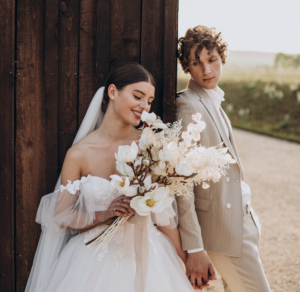
Düğün buketi, bugün modern gelin estetiğinde merkezi bir rol üstlenmeye devam ediyor. Değişen moda akımlarına göre gelin buketlerinin tarzları da değişiyor. Hatta canlı buket yerine yapma çiçekler de kullanılıyor.
Gelin çiçeği seçiminde neler göz önünde tutulmalı?
Sevgili gelin adayları, düğününüzde geleneksel, minimal, salaş, mevsime uygun hatta üzerinde çiçek olmayan buketleri tercih edebilirsiniz ama önce önerilerimize göz atın:
-Her şeyden önce çiçeği gelinin beğenmesi gerekir. Hayatının en önemli günlerinden biri olan düğün gününde, gelin adayının söz sahibi olması önemlidir. Gelin, çiçeğin rengi ve kokusu konusunda belirleyici olabilir.
-Gelinlik ve çiçeğin birbirine uyumlu olması gerekir. Sade, minimal bir gelinlik, elbisenin göz ardı edilmemesi için yine minimal bir buketle tamamlanabilir. Başka bir söylemle kabarık etekli balo elbisesi görünümündeki gelinlik için daha komplike, büyük bir buket gerekir.
-Çiçeğin mümkün olduğunca hafif olması gelinin onu rahatça taşıması açısından önemlidir. Uzun süren düğünlerde ağır bir çiçek gelin için sorun olacaktır.
-Gelin, canlı ve doğal bir çiçek tercih ediyorsa, mevsim çiçekleri arasından seçim yapılmalıdır.
-Çiçeğin saçla da uyumlu olması gerekir. Saçlar sade ise çiçek buketi abartılı olabilir.
-Düğün açık havada yapılıyorsa, çiçeklerde yeşil, mor, eflatun, mavi gibi renkler seçilebilir.
-Kır düğünü ise papatyalarla bezenmiş yeşillikler seçmenizi öneririz.
-Buket gelinin boyu ile orantılı olmalıdır. Kısa boylu bir gelinin uzun bir buket taşıması yanlış olur.
-Eğer isterseniz yakın arkadaşlarınız, anneniz, nedimeniz için de minik buketler ya da bileklerine takacakları uygun renkte çiçekler hazırlatabilirsiniz.
ELİF OVAR
Bride and Flowers
There are many accessories that complement the wedding dress, from the veil to the tiara, from shoes to gloves. Flowers are the most meaningful of these accessories.
The relationship between the bride, who embarks on a brand new journey full of love and hope, and the flower, which is loaded with meanings such as love, freshness, beauty and naivety, is very deep. In almost every culture, we see the bride and the flower coming together in some way during the wedding.
Now, let’s examine the unity of “bride and flower” whose beginnings date back centuries.
The meaningful relationship between the bride and flowers…
Flowers have an important place in our culture. Flowers, which are also used symbolically in stories and manis, are associated with concepts such as love, abundance and beauty and are widely used both in art and weddings. In our culture, colorful needlepoint floral motifs or flower-shaped jewels were used in abundance in the scripts and headdresses worn by brides at weddings. Flowers were embroidered on the silk or velvet fabrics that the bride would wear.
In some tribes of ancient Turks, the groom’s friends would go to the girl’s house with the wedding procession and the best man would prepare a bunch of flowers for the bride. When the bride was taken by horse and brought to the boy’s house, the groom and the best man would approach the horse and unload the bride, and immediately afterwards the best man would give the bride the carefully prepared flower. We continue to have similar customs.
Flowers were widely used in Ottoman palace weddings. The places where the wedding would take place would be decorated with flowers. In addition to the jewelry or clothes that the groom had to send to the palace, it was an indispensable custom to include flowers. The Ottoman archive documents show that flowers were among the valuable gifts sent by Ali Pasha, who married Safiye Sultan, the sister of Ahmet III. In addition, during the dowry processions, which were watched with curiosity by the public, it was also a custom of the time to have flowers in trays.
Roman and Egyptian brides
In Roman and Egyptian civilizations, brides-to-be used to carry fragrant herbs in their hands to prevent the approach of evil. Among these fragrant herbs, rosemary represented loyalty and ivy represented the strength of the bond.
For the protection of the bride, basil or black cumin was kept. The flower crowns they wore symbolized fertility and new beginnings. In addition, flowers were also used as decoration for weddings in those times.
Let’s talk about the European Middle Ages…
As Turks, we have been a race that respects water and pays attention to cleanliness for thousands of years. In medieval Europe, however, the situation was completely different; even though the Roman baths were still in use, they were insufficient due to the increasing population. There was no hygiene due to epidemics, animal droppings on the city streets, and waste being dumped on the streets. As if this was not enough, St. Julian, one of the religious leaders, forbade his followers to bathe, while St. Jerome directed his subjects by saying “bathing is only allowed during baptism”. As a result, Christians almost shelved bathing. Most of the time, bathing consisted only of pouring water from a pitcher over the body. People had to carry water to their homes to bathe, and they all bathed in the same barrel, one after the other, in water that got dirtier and dirtier. Imagine the stench of not bathing in those times…
According to some sources, in the European Middle Ages, the first bath of the year took place in May.
The only way to prevent the stench of the time was to use fragrant flowers or herbs. Some researchers attribute the use of flower bouquets at weddings to this reason. According to them, brides had to carry a bouquet of flowers to hide the bad odors emanating from their bodies during the wedding.
According to another claim, the bride would walk through the village until she reached the church where the wedding was to take place, during which the villagers would give her flowers plucked from the surrounding area. The bride would enter the church with the bouquet of flowers in her hand and attend the wedding.
And the era of Elizabethan England…
During this period, flower bouquets were used even more for decorative purposes. Small bouquets became a must-have for brides and even small bouquets of fragrant flowers were given to guests as gifts. Brides who followed the fashion of the time started to sprinkle flowers in their elaborate hair to add elegance to their elegance.
19th century Victorian Era…
Turks are famous for their fondness and love for flowers. Our flower culture reached its peak during the reign of Suleiman the Magnificent when the gardens in Istanbul were adorned with flowers and this culture started to attract the attention of Europeans. Many flower seeds were taken back to their countries by Europeans and the gardens there were also adorned with flowers.
In Europe, which learned not only flowers but also the language of flowers from the Turks, the language of “floriography”, which means that flowers have different meanings according to their colors and numbers, was formed during the Victorian period. As a natural reflection of this, brides began to carefully choose flowers to express their feelings to their future husbands or to those around them. Even secret messages have become communicated through flowers.
The birth of today’s bridal bouquet style in the modern sense coincides with the Victorian era. Following Queen Victoria’s bouquet and the orange blossoms she wore in her hair at her wedding in 1840, flowers first became a fashion and then a commercial commodity and an accessory of the bridal industry.
Bridal flowers today…
Today, the wedding bouquet continues to play a central role in the modern bridal aesthetic. The styles of bridal bouquets change according to changing fashion trends. Even artificial flowers are being used instead of live bouquets.
What should be considered when choosing a bridal bouquet?
Dear brides-to-be, you can choose traditional, minimal, shabby, seasonal or even non-flower bouquets for your wedding, but first take a look at our suggestions:
-First of all, the bride should like the bouquet. It is important for the bride-to-be to have a say on her wedding day, one of the most important days of her life. The bride can be decisive about the color and scent of the flower.
-The wedding dress and the flower should be in harmony with each other. A simple, minimal wedding dress can be complemented with a minimal bouquet so that the dress is not overlooked. In other words, a wedding dress that looks like a ball gown with a puffy skirt needs a more complicated, large bouquet.
-It is important that the bouquet is as light as possible for the bride to carry it comfortably. A heavy flower will be a problem for the bride during a long wedding.
-If the bride prefers a live and natural flower, she should choose from seasonal flowers.
-The flower should also be compatible with the hair. If the hair is plain, the flower bouquet may be exaggerated.
-If the wedding is held outdoors, colors such as green, purple, magenta and blue can be chosen for the flowers.
-If it is a countryside wedding, we recommend choosing greenery adorned with daisies.
-The bouquet should be proportional to the bride’s height. It would be wrong for a short bride to carry a long bouquet.
-If you wish, you can have small bouquets prepared for your close friends, your mother, your bridesmaids, or flowers in appropriate colors to be worn on their wrists.



